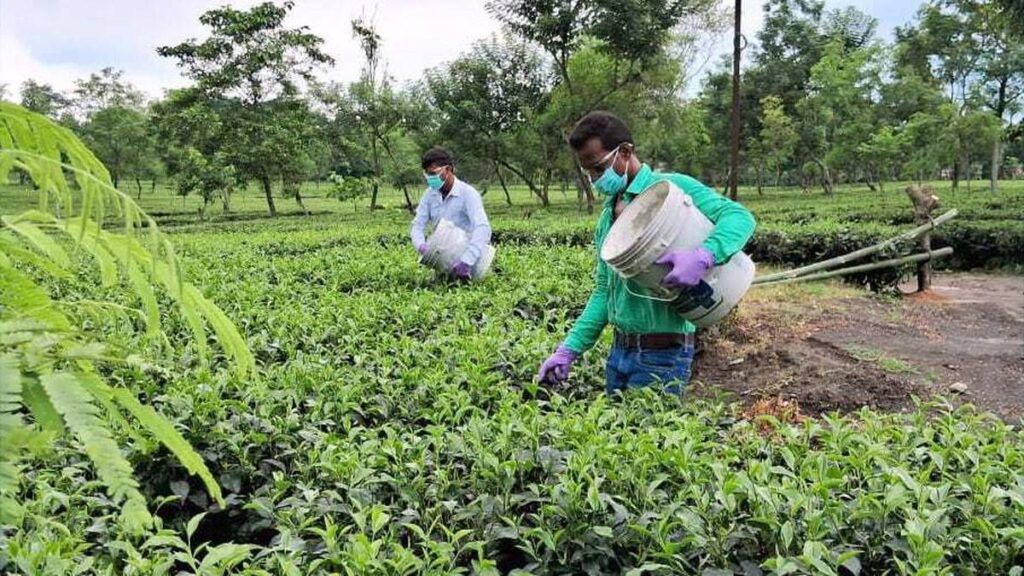
Alt Carbon collects crushed basalt from the Rajmahal mines and has them sprinkled on their tea estates. Photo: Special Arrangement
The last thing you would expect is that dust from mining would be climate friendly. But the right kind of dust moved to the right place is the core business of a Darjeeling-based company, Alt Carbon, and has already garnered $5,00,000 in investments for carbon-credit companies. At the heart of the company’s approach is the geo-chemical process called rock weathering.
All rocks naturally break down into minerals over thousands of years. This happens mainly due to being exposed to rain and heat, and the consequence of this process is that atmospheric carbon reacts with these minerals (calcium and magnesium largely) and becomes bicarbonates.
Eventually through aquifers, or underground streams and rivers, they make their way into the oceans where the carbon is locked in for aeons.
The oceans, thus, are the major carbon sinks and capture about 30% of the CO2 from human activities. Left to nature, this process takes aeons. However, with the levels of carbon dioxide building up in the air and a consensus by the Intergovernmental Panel on Climate Change that some amount of carbon dioxide already present in the air needs to be removed by 2050, for keeping temperatures from exceeding 2 degree Celsius by the end of the century, governments as well as businesses are experimenting and investing in schemes to accelerate natural carbon removal processes. This is where ‘enhanced’ rock weathering comes in.
Basaltic rock, a kind of volcanic rock, is rich in minerals such as calcium and magnesium. Many parts of Maharashtra and Gujarat, where the volcanic Deccan Traps are located, are rich in such basaltic rock as parts of Jharkhand and West Bengal where the Rajmahal Traps are situated. The latter are regularly mined for construction.
“Once such basaltic rock is crushed into a fine powder, its effective surface area is greatly increased. This accelerates the formation of bicarbonate anywhere from ten-fold to a hundred-fold and can be flushed into the ocean – depending on the soil, temperature and rivers – within a month,” said Dr Sambuddha Misra, associate professor and expert in chemical oceanography, at the Indian Institute of Science, Bengaluru. He is also the chief scientist at Alt Carbon.
The company, which derives from a family-owned tea-garden industry, collects tonnes of crushed basalt from the Rajmahal mines, transports it about 200 kilometres away to Darjeeling and has them sprinkled on tea estates in the region.
Being an organic fertiliser, the basaltic dust enriches the soil as well as accelerates carbon sequestration. So far, the company has used about 500 tonnes of dust. Though still early years, it takes about a 3-4 tonnes of basalt dust to sequester, or trap, a tonne of atmospheric carbon over two to four years. “Normally it would have taken 1,000 years for natural basaltic rock to capture that much carbon,” said Shrey Agrawal, CEO and co-founder, Alt Carbon.
Every tonne of carbon sequestered this way counts as a single carbon credit. This September, the company entered into an agreement with Frontier, a consortium of McKinsey Sustainability, Alphabet, Meta, Shopify and Stripe, to buy a tranche of carbon sequestered this way in advance for $5,00,000. Last week, the company entered into another agreement with NextGen, a company that aggregates such carbon captures from projects around the world, to buy an undisclosed number of such credits at the rate of $200 per tonne of locked carbon. Carbon credits generated this way are bought by companies and they can use it to offset their carbon emissions, required under their national laws. Currently though, such purchases are largely voluntary.
While the basic principle of enhanced rock weathering is fairly well established, questions remain on whether processes employed by different companies are accurately measuring the claimed, sequestered carbon. An analysis by research group Carbon Plan, which synthesised existing published literature on results of weathering experiments, said that the variation that existed between 116 such studies spanned “four orders of magnitude” meaning some projects claimed 100 tonnes and others 10,00,000 tonnes of trapped carbon for similarly conducted experiments. Factors such as rock, the kind of agricultural fields, climate significantly influenced weathering. There were also yearly differences with faster weathering in the initial stages and slower ones subsequently. There were also variations in the way projects measured the rate of sequestration.
“We hope to sequester about 50,000 tonnes in the next few years. The lab facilities set up by Dr. Misra is precisely to measure these aspects of weathering. We have a protocol called FELUDA that can be used by other companies interested in using our approach,” said Mr. Agrawal.
Published – October 20, 2024 04:30 am IST

